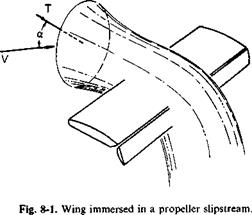Wings and propellers separately and in combination at high angles of attack
Many schemes for VTOL or STOL aircraft employ wings or propellers operating in an angle of attack range of zero to 90°. A prediction of their behavior under these conditions requires a blending of analytical considerations and experimental results. Not only is each problem separately
|
|
difficult, but the difficulty is compounded when the wing and propeller are interacting with one another.
Consider the wing-propeller combination shown in Fig. 8-1, in which a portion of the wing is immersed in the propeller slipstream and is therefore under the influence of a velocity different from the outer portion. The outer portion may be completely stalled, whereas the inner portion may not. The
212
lift on the inner portion occurs as a result of deflecting the flow in the slipstream and the flow external to it. In turning the slipstream, the wing reduces the forward component of the propeller thrust.
An entirely analytical solution to this problem is unlikely in view of the real fluid effects involved, such as stalling. Hence in the final analysis we resort to semiempirical approaches. Nevertheless, some insight into the behavior of the wing-propeller system is provided by analytical means. We begin by considering the behavior of the propeller alone. A combination blade element-momentum theory is used for the propeller.












